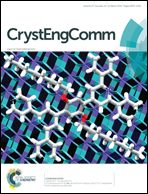Assembly of organic–inorganic hybrid materials constructed from polyoxometalate and metal–1,2,4-triazole units: synthesis, structures, magnetic, electrochemical and photocatalytic properties†
Abstract
A series of organic–inorganic hybrid compounds built from Keggin and Wells–Dawson polyoxometalates and TM-trz complexes (Htrz = 1,2,4-triazole) were obtained at different pH values under hydrothermal conditions, namely, [Co2(H2O)2(Htrz)5][SiW12O40]·2.5H2O (1), [Zn5(Htrz)8(trz)2(H2O)8][SiW12O40]2·10H2O (2), [CuI2CuII4(Htrz)4(trz)4Cl2][GeW12O40]·15H2O (3), [CuI2CuII4(Htrz)4(trz)4Cl2][SiW12O40]·15H2O (4), K2Na2(H2O)2[Co11(trz)14(H2O)14][P2W18O62]2·29H2O (5) and [Cu12(trz)10(Htrz)2(OH)4(SO4)2(H2O)6][P2W18O62]·28H2O (6). All of the compounds were characterized using single-crystal X-ray diffraction, TG analysis and powder X-ray diffraction. Compound 1 contains a kind of bimetallic–organic segment [Co2(Htrz)5]4+, which could be regarded as a quasi-sinusoid-like chain. 2 is a dimer constructed from two [SiW12O40]4− units linked by a [Zn5(trz)2(Htrz)8]8+ motif. In 3 and 4, the 2D wall-like layers constructed by the Cu(II) ions and Htrz ligands are extended into 3D frameworks by polyanions. 5 shows a complicated three-dimensional (3D) framework with a {412·612·84}{46}2 topology. Compound 6 is also a complicated 3D structure based on a triangular trinuclear Cu-trz unit and [P2W18O62] polyanions. To the best of our knowledge, 6 represents the largest copper cluster linked by amines in a POM system. Structural diversities reveal that the pH value of the reaction system plays a crucial role in the assembly of POM-based hybrids. Moreover, the optical band gaps, electrochemical properties, magnetic properties and the photocatalytic properties of the compounds have been investigated.


 Please wait while we load your content...
Please wait while we load your content...